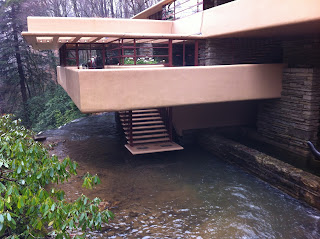Built between 1936 and 1939, Falling Water, Frank Lloyd
Wright’s creation for the Kaufmann family of Pittsburgh,PA, continues to be an
impressive work of architecture that attracts thousand
of visitors every year.
Falling Water is located in the Laurel Highlands of
Pennsylvania. It’s takes about an
hour-and-a-half to get to Falling Water from Pittsburgh, and about four hours
from Washington, DC. The house is in the woods, between the towns of Mill Run
and Ohiopyle. Visitors walk from the ticket office and souvenier shop up a
gravel path to Falling Water.
 |
| View of deck over stream, Falling Water, PA. |
Most people are familiar with Falling Water from books and
magazine articles, but never have a chance to visit. The stream that runs
underneath the large deck and then over stones to a pool below, gives visitors
the impression they have walked into a futuristic scene, and yet the houe was
built in the late 1930s.
The Kaufmann’s had owned land outside of Pittsburgh for
years and had been visiting the area mostly during the summer to escape from
the city heat. According to one of the tour guides, the temperature at Falling
Water is usually 10 degrees cooler than in Pittsburgh. As a result of their
success in the department store business the Kaufmann’s commissioned Wright to
design and construct a home for them on their country property. Wright’s
philosophy, according to the tour guide, was to build structures that seemed to
develop from the natural surroundings. His goal was to build structures that
blended in with their environment. Rather than cut trees and move heavy stones,
Wright sought ways to build structures that complemented the natural scene. For
example, one large boulder in the stream that other architects would have moved
out of the way, serves as a foundation stone for part of Falling Water.
 |
| View of Falling Water, designed by Frank Lloyd Wright in late 1930s. |
Falling Water was intended to be a showpiece that the
Kaufmann’s could use to entertain friends from the worlds of business and art.
Our tour guide informed us that artists from the U.S., Europe, and Mexico had
stayed at Falling Water. Art work by Diego Rivera and Frida Khalo is
prominently displayed in Falling Water. In fact, Frida Khalo spent several days
visiting with the Kaufmann’s in the 1940s, said the tour guide.
The tour guide also pointed out the screens on the small
windows. Wright did not like screens because he felt they created a barrier
people and nature. However, in the 1960s the Board of Directors of Falling
Water, after the Kaufmann’s only son, Edgar, had given up the home, voted to
install screens. Visitors were complaining about the insects that were coming
into the house, especially mosquitos, said the tour guide and the Board of
Directors finally approved a measure to override the wishes of Wright and
install screens. Wright would not have been happy.
A tour of Falling Water will not disspoint. The views of the
house itself, the views of the natural scenery from inside the house, and the
elegance and style of the interior of the house will leave lasting impressions
on visitors that make the visit well worth the effort.

No comments:
Post a Comment